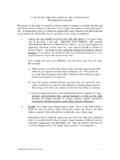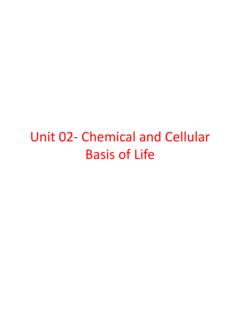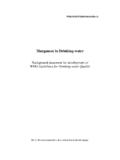Transcription of Immune diseases and children - who.int
1 TRAINING FOR THE HEALTH SECTOR. [Date Place Event . Event Sponsor . Sponsor Organizer]. Immune diseases AND children . children 's Health and the Environment WHO Training Package for the Health Sector World Health Organization October 2011 1. <<NOTE TO USER: Please add details of the date, time, place and sponsorship of the meeting for which you are using this presentation in the space indicated.>>. <<NOTE TO USER: This is a large set of slides from which the presenter should select the most relevant ones to use in a specific presentation. These slides cover many facets of the problem. Present only those slides that apply most directly to the local situation in the region.
2 >>. 1. Immune diseases and children LEARNING OBJECTIVES. To introduce the complexity of Immune system function and the consequences of its impairment To explain perinatal Immune system vulnerability To present some examples of current evidence of associations between environmental risk factors and Immune system impairment 2. <<READ SLIDE>>. 2. Immune diseases and children OVERVIEW. Immune system and Immune diseases Perinatal vulnerability and developmental immunotoxicity Environmental risk factors associated with Immune adverse effects Biomarkers of Immune alteration Further research new challenges 3.
3 <<READ SLIDE>>. 3. Immune diseases and children IMMUNITY. Complex, highly regulated, multicellular, physiologic mechanisms designed to accomplish a singular goal: to differentiate self from non self 4. Immunity depends on an intricate homeostatic system aimed at maintaining a delicate balance between health and disease. Its function is maintained by a series of complex, highly regulated, multi- cellular , physiologic mechanisms designed to accomplish a singular goal: to differentiate self from non-self. The healthy Immune system has the ability to distinguish between the body's own cells, recognized as self and foreign cells, or non-self.
4 When the Immune system is challenged by a microbe, it has many defense barriers and types of responses to choose. The Immune defenses normally coexist peacefully with cells that carry distinctive self marker molecules. Anything that can trigger this Immune response is called an antigen. An antigen can be a microbe, or a part of a microbe such as a molecule. Tissues or cells from another person (except an identical twin) carry non-self markers and act as foreign antigens. In abnormal situations, the Immune system can mistake self for non-self and launch an attack against the body's own cells or tissues.
5 Immunocompetence is maintained by the concert of lymphoid organs, specific and non-specific cellular and humoral factors. All Immune cells begin as immature stem cells in the bone marrow. They respond to different cytokines and other chemical signals to grow into specific Immune cell types, such as T cells, B cells, or phagocytes. Lymphocytes known as T lymphocytes or T cells ( T stands for thymus ) mature in the thymus and then migrate to other tissues. B lymphocytes, also known as B cells, become activated and mature into plasma cells, which make and release antibodies or immunoglobulins (G, M, A, E and D).
6 T cells contribute to Immune defenses in two major ways: some direct and regulate Immune responses, whereas others directly attack infected or cancerous cells. Helper T cells, or Th cells, coordinate Immune responses by communicating with other cells, promote activation of cytotoxic T lymphocytes (CTLs) and B cells to become memory cells. CTLs also called killer T cells directly attack other cells carrying certain foreign or abnormal molecules on their surfaces. Natural killer (NK) cells are another kind of lethal white cell with granules filled with potent chemicals. NK cells recognize cells lacking self-MHC (histocomatibility) molecules.
7 Thus, NK cells have the potential to attack many types of foreign cells. Phagocytes or macrophages are large white cells that can swallow and digest microbes and other foreign particles. Monocytes are phagocytes that circulate in the blood. Dendritic cells are found in the parts of lymphoid organs where T cells also exist. Like macrophages, dendritic cells in lymphoid tissues display antigens to T cells and help stimulate T cells during an Immune response. Cytokines or lymphokines are chemical messengers secreted by Immune cells and act on other cells to coordinate appropriate Immune responses. Cytokines include a different types of interleukins (IL), interferons (IFN), and growth factors.
8 Chemokines often play a key role in inflammation. The complement system is made up of about 25 proteins that work together to assist, or complement, the action of antibodies in destroying microbes. Ref and image: National Institutes of Health. Understanding the Immune system. How it works . Department of Health and Human Services. National Institutes of Health National Institute of Allergy and Infectious diseases , National Institutes of Health Publication No. 07-5423, September 2007. 4. Immune diseases and children IMMUNITY. Cytokines: hormonal messengers in the Immune system Cytokines can be proinflammatory or anti-inflammatory T lymphocytes: major source of cytokines: antigen specific receptors on their cell surface to allow recognition of foreign pathogens.
9 T lymphocytes expressing surface molecule CD4 are also known as helper T cells Helper T cells are subdivided into Th1 and Th2, and the cytokines they produce are Th1-type cytokines and Th2-type cytokines. Th1-type cytokines tend to produce the proinflammatory responses Th2-type cytokines deal with responses in atopy and anti- inflammatory responses. 5. Cytokines: hormonal messengers for most of the biological effects in the Immune system ( cell mediated immunity and allergic responses). Cytokines can be proinflammatory or anti-inflammatory (but that promote allergic responses). T lymphocytes are a major source of cytokines: antigen specific receptors on their cell surface to allow recognition of foreign pathogens.
10 There are two main subsets of T lymphocytes, distinguished by the presence of cell surface molecules known as CD4 and CD8. T lymphocytes expressing CD4 are also known as helper T. cells, and these are regarded as being the most prolific cytokine producers. This subset can be further subdivided into Th1 and Th2, and the cytokines they produce are known as Th1-type cytokines and Th2-type cytokines. Th1-type cytokines tend to produce the proinflammatory responses responsible for killing intracellular parasites and for perpetuating autoimmune responses. Th2-type cytokines deal with responses in atopy and anti-inflammatory responses.


















